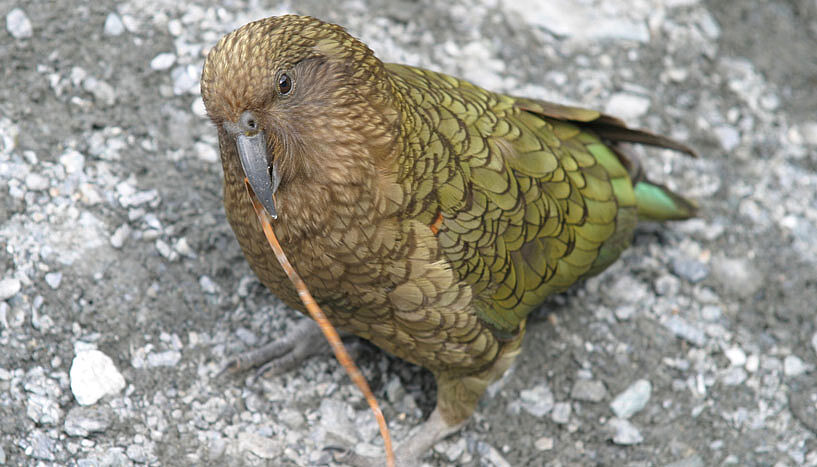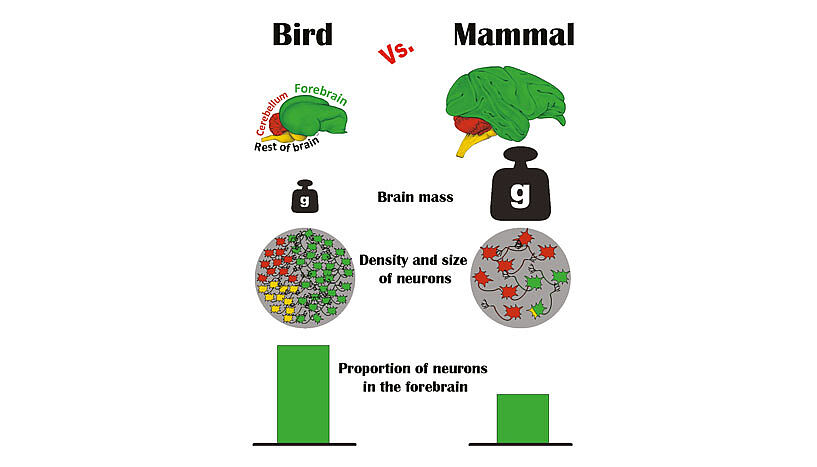Birds Pack More Neurons into Smaller Brains
14. June 2016Why "bird brain" should be a compliment, not an insult
Being called a "bird brain" should be considered a compliment: An international team of scientists including Tecumseh Fitch of the University of Vienna has found out that birds have a more efficient neural architecture, allowing them to fit many more neurons into smaller brains than can mammals. More neurons means more computing power. Furthermore, the brains of particularly smart birds, like ravens and parrots, have disproportionately more forebrain neurons involved in complex cognition. These results are published in the renowned journal PNAS.
Although the English phrase “bird brain” implies a lack of intelligence, research over the last decades has clearly shown that some birds are very clever, and can match or outsmart the smartest monkeys. Ravens and jays know when someone has seen them hide food, and re-hide it when they’re gone, magpies recognize themselves in mirrors, and New Caledonian crows make and use sophisticated tools. Parrots are the only non-humans that can dance to a beat without training, and some parrots even drum on trees with sticks. Grey parrots can learn hundreds of words and use them meaningfully. The list could go on: but how do birds achieve such mental feats when their brains are quite small compared a mammal with a similar-sized body?
A team of scientists in the Czech Republic, USA and Austria has found the answer: birds have a more efficient neural architecture, allowing them to fit many more neurons into smaller brains than can mammals. Because neurons are the individual brain cells that perform cognitive computations, more neurons means more computing power. Furthermore, the brains of particularly smart birds, like ravens and parrots, have disproportionately more forebrain neurons involved in complex cognition.
The team, led by Pavel Němec at the Charles University in Prague, used a new technique to count the neurons in the brains of 28 avian species, finding that the brains of songbirds and parrots contain very large numbers of neurons, at densities exceeding those in mammals. They used a new method, developed by Suzana Herculano-Houzel at Vanderbilt University in the US, which allows neuronal number to be quickly and accurately counted; the method had previously been used only on mammals.
Co-author Tecumseh Fitch, at the Department of Cognitive Biology at the University of Vienna, explained: “Brains of humans and other mammals put neurons into a layered structure called neocortex, like a layer cake. This neocortical cake can only have six layers, so if you want more neurons you must expand the cake laterally – you can’t add more layers. But neurons in larger cakes get further from each other, requiring longer and fatter connections that waste space". In humans, these connections (the white matter of the cortex) take up almost half the space.
Birds, in contrast, have a nuclear architecture, allowing neurons to be more efficiently packed. "In bird brains, the neurons are like raisins in a pudding, and you can pack the neurons where they’re needed, without lots of space-wasting long connections." Fitch compared the bird architecture to a new style of computer chip that manages to fit more transistors into a smaller silicon chunk. Probably due to bird flight selecting for light weight, evolution has stumbled upon a more efficient way to make smart brains in a smaller, lighter package in birds.
"For a long time having a 'bird brain' was considered to be a bad thing: Now it turns out that it should be a compliment," quipped Herculano-Houzel.
Co-authors on the study were Seweryn Olkowicz, Martin Kocourek, Radek Lučan and Michal Porteš at the Charles University in Prague.
Publication in "PNAS":
Birds have primate-like numbers of neurons in the forebrain: Seweryn Olkowicz, Martin Kocourek, Radek Lučan, Michal Porteš, W. Tecumseh Fitch, Suzana Herculano-Houzel, Pavel Nemec. In PNAS Online Early Edition
Doi: 10.1073/pnas.1517131113
Scientific contact
Univ.-Prof. W. Tecumseh Fitch
Department für KognitionsbiologieUniversität Wien
1090 - Vienna, Althanstraße 14
+43-1-4277-761 11
tecumseh.fitch@univie.ac.at
Further inquiry
Mag. Alexandra Frey
Media Relations ManagerUniversität Wien
1010 - Wien, Universitätsring 1
+43-1-4277-17533
+43-664-8175675
alexandra.frey@univie.ac.at
Downloads:
Fitch_Graphical_abstract.pdf
File size: 1,23 MB


